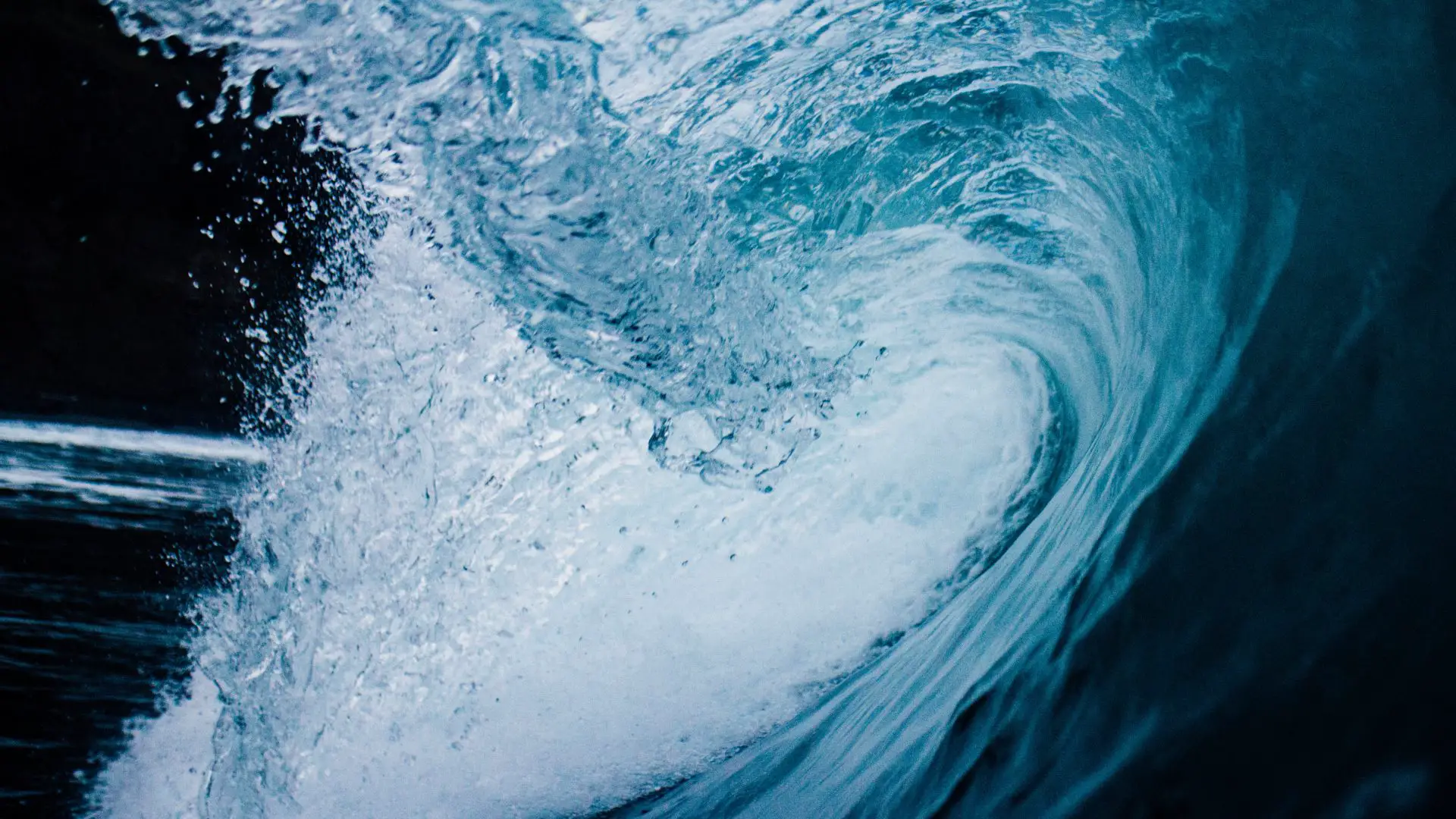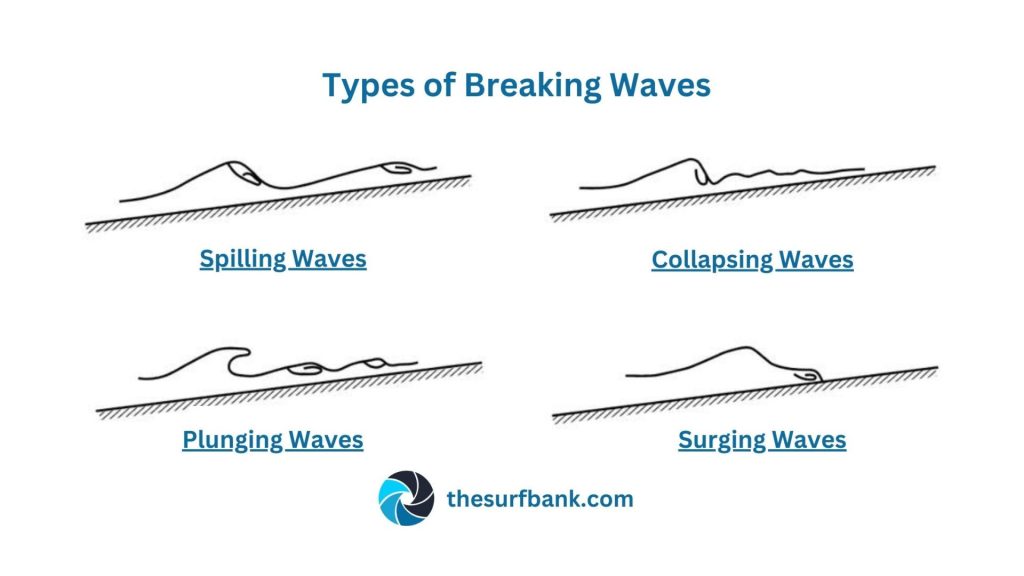4 Types of Breaking Waves Explained!

Waves break daily across our world’s oceans, however each breaking wave isn't the same.
There are 4 types of breaking waves all of which offer different experiences for surfers.
4 Types of Breaking Waves
The 4 main types of breaking waves are spilling, plunging, surging and collapsing waves.
4 Breaking Waves Diagram

Spilling Waves Definition
Spilling waves are characterised by a gentle breaking motion, where the wave crest spills down its front.
Plunging Waves Definition
Plunging waves exhibit a forceful breaking pattern with a steep motion, often creating a crashing effect.
Surging Waves Definition
Surging waves break in a rolling manner, featuring a more consistent and gradual break compared to other types.
Collapsing Waves Definition
Collapsing waves, also known as shore break, break directly on the shore with significant force, resulting in a sudden impact on the coastline.
Spilling Waves
Spilling waves typically occur on gradual beach slopes, featuring short and steep wave profiles.
Unlike plunging waves with dramatic curls or crashing waves, spilling waves break farther from the shore, creating wider surf zones.
The gradual slope allows these waves to spill slowly as they reach a depth 1.3 times their height, providing a smoother and approachable surfing experience, making them perfect for beginners and those seeking a relaxed day at the beach.
Plunging Waves
Plunging waves, often favoured by experienced surfers, exhibit the classic wave shape with a crest that curls over and plunges dramatically.
Found on consistent or gradual beaches, these waves are formed by either long-period swells on shallow slopes or shorter-period swells on steep slopes, resulting in a narrow surf zone.
Offering the perfect ride, surfers seek the thrill of navigating inside the barrel created by the curling crest.
Surging Waves
Surging waves present a unique phenomenon occurring when a long-period swell approaches a very steep beach, causing the wave's base to surge up before collapsing.
Less common than other types, surging waves contribute to a dynamic coastal environment and can pose risks such as undertow currents.
The interaction between specific swells and steep beaches creates these distinct surging conditions, adding complexity to the coastal landscape.
Collapsing Waves
Collapsing waves, a captivating aspect of wave behaviour, occur when the crest of the wave collapses due to its own weight and energy.
This dynamic process is influenced by factors such as wave steepness, velocity, and interaction with the seafloor.
As waves transition from deep to shallow water, the frictional effect of the seabed slows the bottom of the wave. When the top overtakes the bottom, the wave reaches a critical point leading to it breaking.
Other Types Of Ocean Waves
Ripples
Ocean ripples are small, regular waves caused by local winds or disturbances on the water's surface. These ripples have shorter wavelengths and lower amplitudes compared to larger ocean waves, creating a subtle but noticeable pattern across the sea that later form waves that we can surf.
Chop
Chop refers to small, disorganised waves typically caused by local winds in the absence of a strong swell. These waves create a rough and irregular surface on the water, making it choppier and less smooth for various water activities.
Swell
Swell refers to a series of regular, undulating ocean waves generated by distant weather systems. These waves have a longer wavelength and travel across vast stretches of ocean, carrying energy over great distances.
Wave Breaking Criteria
Wave breaking occurs when specific conditions align, primarily dictated by the interaction between the wave and its surrounding environment.
The critical criteria for wave breaking include the ratio of wave height to wavelength exceeding 1/7, indicating that a wave becomes too steep.
This phenomenon is influenced by factors such as wind direction, ocean floor slope, and the depth of water.
Summing It Up: What To Do Now
Nice! Now you know all of the 4 breaking waves it's time to get back out there. Be sure to know which break your local surf spot has!
If your interested in learning more about surfing discover our many guides that will inform you on your surfing journey. Don't forget to follow us on Facebook & Instagram to stay informed on our amazing surf shots and stories shared from surf creators around the world!
Frequently Asked Questions
Which are 3 types of breaking waves?
The three types of breaking waves are spilling waves, plunging waves, and surging waves.
What are the 4 types of breaking waves?
Ocean waves can be classified into wind waves, swell waves, choppy waves, and rogue waves.
What are 3 types of mechanical waves?
The three types of mechanical waves are transverse waves, longitudinal waves, and surface waves.
What are the 4 types of waves?
The four types of waves are mechanical waves, electromagnetic waves, matter waves, and gravitational waves.
What is breaking waves in physics?
Breaking waves in physics refer to the point at which the forward motion of a wave crest is disrupted, leading to the wave transitioning from a crest to a turbulent mixture of air and water.
What are 3 types of waves and what makes them different?
The three types of waves, mechanical, electromagnetic, and matter waves, differ based on the medium they require for propagation and their distinct characteristics in physics.


